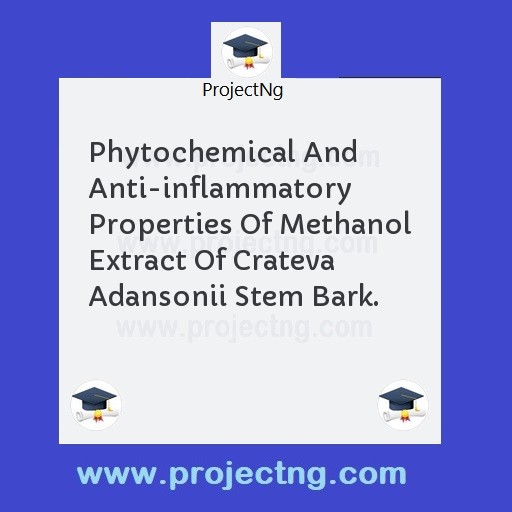Phytochemical And Anti-inflammatory Properties Of Methanol Extract Of Crateva Adansonii Stem Bark.
Accounting Project Topics
Get the Complete Project Materials Now! »
ABSTRACT
78
This research investigated the phytochemical and anti-inflammatory properties of methanol extract of Crateva adansonii stem bark. Although several edible and non-edible plants parts are used in inflammatory treatment, many record has been found of the use of Crateva adansonii stem bark. For this research, fresh stem bark of Crateva adansonii were collected from Asata village in Enugu State. The cuttings were authenticated at the Bioresource development centre. They were then dried at room temperature for one month in an open lab space, grounded into powder and weighed on a beam balance as 460.6g. The powder was soaked for twenty-four to fourty-eight hours in methanol to get a methanol extract and then concentrated into paste at a set temperature range of 30-550C in a water bath. A population of twenty adult wistar Albino rats was used for anti-inflammatory test. The rats were divided into five (5) groups of four (4) albino rats each. They were administered 3% tween-80 mixed with dichloromethane extract of Crateva adansonii and the control was administered with 0.5ml of 3% tween-80. Acute inflammation was induced an hour after test substances were administered by injecting egg albumin in the subplanter region of the right hind paw and edema assessed by mercury displacement for a period of 0-180 minutes. Anti-inflammatory effect was significant within 30 minutes of induced edema with inhibition occurring in three phases of 0-30, 30-60, 60-90. 90-120 to 180 minutes. Inhibition was highest at the third phase. Crateva adansonii barks showed anti-inflammatory effect by inhibiting “prostaglandin” synthesis an inflammatory mediator
78
TABLE OF CONTENTS
Title Page ---------------------------------------------------------------------i
Certification Page-----------------------------------------------------------ii
Dedication--------------------------------------------------------------------iii
Acknowledgements---------------------------------------------------------iv
Abstract-----------------------------------------------------------------------v
Table of Contents-----------------------------------------------------------vi
CHAPTER ONE
1.0 Introduction----------------------------------------------------------1
1.2 Crateva Adansonii as a Plant-------------------------------------5
1.3 Distribution-----------------------------------------------------------6
1.4 Scientific Classification---------------------------------------------6
1.5 Properties -------------------------------------------------------------7
1.6 Research Aim and Objectives-------------------------------------8
1.7 Background of Study------------------------------------------------8
CHAPTER TWO-LITERATURE REVIEW
2.0 Definition of Inflammation---------------------------------------10
2.1 Principle of Inflammation ---------------------------------------10
2.2 Types of Inflammation -------------------------------------------12
2.3 Categories of Inflammation Mediated by the Immune
System ---------------------------------------------------------------13
2.4 Mediators of Inflammation---------------------------------------22
2.5 Histamine and Serotonin------------------------------------------29
78
2.6 The Coagulation Mechanism-------------------------------------30
2.7 Fibrinolysis-----------------------------------------------------------35
2.8 The Kinin – Forming System--------------------------------------36
2.9 Inflammation and Diseases ----------------------------------------40
2.10 Ways of Treating Inflammation-----------------------------------40
2.11 Immune Selective Anti-inflammatory ---------------------------42
2.12 The Use of Herbs in the Treatment of Inflammation---------43
2.13 Anti-Inflammatory Drugs------------------------------------------44
2.14 Phytochemicals-------------------------------------------------------46
2.15 Glycoside---------------------------------------------------------------47
2.16 Flavonoids--------------------------------------------------------------47
2.17 Tannins-----------------------------------------------------------------49
2.18 Saponins---------------------------------------------------------------49
CHAPTER THREE
3.1 MATERIALS --------------------------------------------------------51
3.1.1 Equipment/Apparatus Used --------------------------------------51
3.1.2 Animal Used----------------------------------------------------------54
3.2.1 Methodology ----------------------------------------------------------55
3.2.2 Extraction--------------------------------------------------------------56
3.2.3 Preparation of Reagents for Phytochemical -------------------56
3.2.3 Phytochemical Analysis of the Extract --------------------------57
3.2.5 Test for Alkaloide---------------------------------------------------57
3.2.6 Test for Saponin------------------------------------------------------58
78
3.2.7 Test for Terpenoids--------------------------------------------------58
3.2.8 Test for Anthraquinones -------------------------------------------58
3.2.9 Test for Coumarins---------------------------------------------------59
3.2.10 Test for Phlobatannins----------------------------------------------59
3.2.11 Test for Flavonoids--------------------------------------------------59
3.2.12 Test for Tannins------------------------------------------------------59
3.2.13 Test for Saponin------------------------------------------------------60
3.2.14 Test for Resins--------------------------------------------------------60
3.2.15 Test for Steroids and Terpenoids --------------------------------61
3.2.16 Test for Glycoside---------------------------------------------------61
3.2.17 Preparation of Reagents for Anti-Inflammatory Test--------62
3.2.18 Test for Anti – Inflammation Activity --------------------------62
3.2.19 Thin layer Chromatorgaphy (TLC)------------------------------65
3.2.20 How to Run A TLC Plate------------------------------------------66
CHAPTER FOUR
4.0 Extraction ------------------------------------------------------------73
4.1 Photochemical analysis of Crateva Adansonii Bark Extract-74
CHAPTER FIVE
5.1 Discussion -----------------------------------------------------------------75
5.2 Conclusion-----------------------------------------------------------------76
REFERENCES-------------------------------------------------------77
APPENDIX------------------------------------------------------------80
78
CHAPTER ONE
1.0 INTRODUCTION
Inflation is a Latin word (inflammare) which is translated means to set on fire. It is a complex biological response of vascular tissue to harmful stimuli such as pathogens, damaged cells irritant. Inflammation is the reaction of vascularized tissue to local injury caused by certain stimuli like infections, chemicals and biochemical agents, thermal or other physical trauma, antigen-antibody interaction etc (Carol, 1994). Without inflammatory response, wounds will not heal and minor infections would be over weening. Though inflammation aims at limiting damage and restoring function, some enzymes and toxic products within phagocytic cells are released to the extend of damaging the tissue. The advent of anti-inflammatory agents has made inflammation which as been a threat to human life due to its complex, multicontent, to loose its power. These anti-inflammatory agents or drugs help reduce, pain by inhibiting inflammation as opposed to opioids, which affects the central nervous system. It also prevent repairs, prevent and stop the consequences of inflammation by acting on the body responses without directly antagonizing the causative agent (Stedman, 2000). These anti-inflammatory process involves the process of balancing pro-inflammatory acute-phase reactants (Russell et al. 2000), altering biochemical pathway
78
forming prostaglandins by inhibiting cyclooxygenase enzyme from catalyzing the reaction, as a result, suppress, compensate and correct the mechanical and structural abnormalities by assistive device. (Masumoto et al.2009).
The inflammatory reaction is phylogenetically and ontogenetically the oldest defense mechanism. The cells of immune system are widely distributed throughout the body, but if an infection or tissue damage occurs. It is necessary to concentrate them and their products at the site of damage.
Be the First to Share On Social

Enjoying our content?
Don't miss out on new videos! Subscribe to our YouTube channel for more awesome content.
Subscribe Now!













